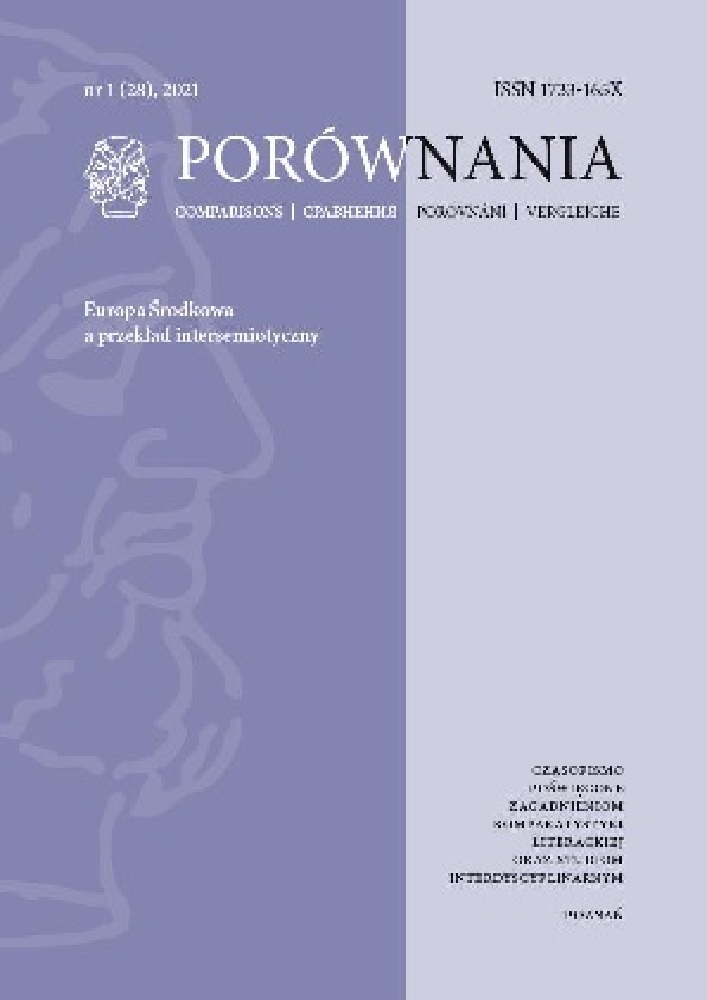Abstract
In this article, I try to describe the relationships (that have been overlooked by researchers) between texts and characters appearing on Rembrandt’s canvases. I am interested in the relationship between the poem by Mandelstam *** [Like Rembrandt, martyr of chiaroscuro…], the essay of Wat Gospel also as a masterpiece of literature and Rembrandt’s image of Christ and – importantly in the case of Wat – the Batavian chieftain, Claudius Civilis. Examples of works by Mandelstam and Wat show that Rembrandt’s painting can be used not only to express personal fears, but also allows to organize the relationship between the human entity and history: thus it becomes not only an aesthetic but also an existential challenge. I also prove that the work of Mandelstam and Wat, so strongly connected with the tragic fate of these poets, found its culmination in their deaths.
References
Achmatowa Anna (2007), Drogą wszystkiej ziemi. Poezja. Proza. Dramat, wybrał, przełożył i komentarzami opatrzył Adam Pomorski, OPEN, Warszawa.
Białostocki Jan (2009), Badania ikonograficzne nad Rembrandtem, w: tenże, O dawnej sztuce, jej teorii i historii, red. Maria Poprzęcka, Antoni Ziemba, Sergiusz Michalski, słowo/obraz terytoria, Gdańsk, s. 223–250.
Brown Clarence (1967), Into the Heart of Darkness: Mandelstam’s Ode to Stalin, „Slavic Review”, t. 26, nr 4, s. 584–604.
Chalard-Fillaudeau Anne (2004), Rembrandt, l’artiste au fil des textes. Rembrandt dans la littérature et la philosophie européenne depuis 1699, L’Harmattan, Paris.
Clark Kenneth (1966), Rembrandt and the Italian Renaissance, Norton, London.
Elzenberg Henryk (1994), Kłopot z istnieniem. Aforyzmy w porządku czasu, Znak, Kraków.
Franken Michiel (2004), Changing Direction: The Reconstruction of the Genesis of Rembrandt „Conspiracy of the Batavians under Claudius Civilis” Reconsidered, „Art Bulletin of Nationalmuseum Stockholm”, t. 11, s. 75–82.
Golahny Amy (2003), Rembrandt’s Reading. The Artist’s Bookshelf of Ancient Poetry and History, Amsterdam University Press, Amsterdam.
Herling-Grudziński Gustaw (2002), Zjawy Saraceńskie, w: tenże, Biała noc miłości. Opowiadania, Czytelnik, Warszawa, s. 181–222.
Kloek Walter (2011), L’Importance des tablaux narratifs en Hollande au XVIIe siècle, w: Ilone et George Kremer. Héritiers de l’Âge d’Or hollandais, red. Walter Kloek, Pinacothèque de Paris, Paris.
Mandelsztam Nadieżda (2015), Wspomnienia, przeł. Jerzy Czech, wstęp Josif Brodski, Agora, Warszawa.
Mandelsztam Osip (1983), Poezje, wybór, redakcja i posłowie Maria Leśniewska, Wydawnictwo Literackie, Kraków–Wrocław.
Mandelsztam Osip (2011), Nieograbiony i nierozgromiony. Wiersze i szkice, wybrał, przełożył i komentarzami opatrzył Adam Pomorski, Wydawnictwo Naukowe i Literackie OPEN, Warszawa.
McQueen Alison (2003), The Rise of the Cult of Rembrandt. Reinventing an Old Master in Nineteenth-Century France, AUP, Amsterdam.
Nordenfalk Carl (1956), Some Facts about Rembrandt’s Claudius Civilis, „Konsthistorisk Tidskrift”, t. 25, nr 1–4, s. 71–93.
Nordenfalk Carl (1982), The Batavians’ Oath of Allegiance. Rembrandt’s Only Monumental Painting, Nationalmuseum, Stockholm.
Oczko Piotr (2009), Wokół batawizmu i sarmatyzmu, w: tenże, W najdroższej Holandyjej… Szkice o siedemnastowiecznym dramacie i kulturze niderlandzkiej, Księgarnia Akademicka, Kraków, s. 93–133.
Pismo Święte Starego i Nowego Testamentu (1990) w przekładzie z jęz. oryginalnych, oprac. zespół biblistów polskich z inicjatywy benedyktynów tynieckich, wyd. 3 popr., Wydawnictwo Pallotinum, Poznań–Warszawa.
Rosales Rodríguez Agnieszka (2008), Śladami dawnych mistrzów. Mit Holandii złotego wieku w dziewiętnastowiecznej kulturze artystycznej, Wydawnictwo Uniwersytetu Warszawskiego, Warszawa.
Silver Larry, Perlove Shelley (2011), Rembrandt’s Jesus, w: Rembrandt and the Face of Jesus, red. Lloyd Dewitt, przedm. Seymour Slive, Philadelphia Museum of Art, Musée du Louvre, Detroit Institute of Art, Philadelphia, Paris, Detroit, s. 75–107.
Simmel Georg (2005), Rembrandt. Szkic z filozofii sztuki, przeł. Wojciech Zahaczewski, przekład przejrzała Kamila Najdek, „Sztuka i Filozofia”, t. 27, s. 98–128.
Stankowska Agata (2013), „żeby nie widzieć oczu zapatrzonych w nic”. O twórczości Czesława Miłosza, Wydawnictwo Naukowe UAM, Poznań.
Śniedziewska Magdalena (2014), Siedemnastowieczne malarstwo holenderskie w literaturze polskiej po 1918 roku, Wydawnictwo Naukowe UMK, Toruń.
Wat Aleksander (2008), Ewangelia także jako arcydzieło literatury, w: tenże, Publicystyka, zebrał, oprac., przypisami, posłowiem oraz indeksami opatrzył Piotr Pietrych, Czytelnik, Warszawa, s. 714–719.
Wat Aleksander (2005), Korespondencja, cz. 1, wybrała, opracowała i przypisami opatrzyła Alina Kowalczykowa, Czytelnik, Warszawa.
Wat Aleksander (1998), O religii: Łubianka 1941 – Italia 1957, w: tenże, Mój wiek. Pamiętnik mówiony, cz. 2, rozm. prowadził i przedm. opatrzył Czesław Miłosz, do druku przygotowała Lidia Ciołkoszowa, Czytelnik, Warszawa, s. 341–351.
van de Wetering Ernst (2011), Rembrandt’s Painting „The Conspiracy of the Batavian under Claudius Civilis”, przeł. Murray Pearson, w: Opstand als Opdracht. The Batavian Comissions. Flinck, Ovens, Lievens, Jordaens, De Groot, Bol, Rembrandt, red. Marianna van der Zwaag, Renske Cohen Tervaert, przeł. Yvette Rosenberg, Murray Pearson, Amsterdam Royal Palace Foundation, Amsterdam, s. 21–26.
Ziemba Antoni (2000), Republika Batawów, w: tenże, Nowe dzieci Izraela. Stary Testament w kulturze holenderskiej XVII wieku, Neriton, Warszawa, s. 99–106.
Ziemba Antoni (2008), Nowa wizja osobowości i twórczości Rembrandta: dwie wystawy Roku Rembrandtowskiego (i jeden obraz polski), „Rocznik Historii Sztuki”, t. 33, s. 29–44.
|
License
Utwory opublikowane w czasopiśmie „Porównania”, na platformie Pressto należącej do Uniwersytetu im. Adama Mickiewicza w Poznaniu są udostępniane na licencji Creative Commons Uznanie autorstwa - Bez utworów zależnych 4.0 Międzynarodowe (CC BY-ND 4.0)
Tym samym wszyscy zainteresowani są uprawnieni do korzystania z utworów opublikowanych pod następującymi warunkami:
-
uznania autorstwa — czyli obowiązek podania wraz z rozpowszechnianym utworem informacji o autorstwie, tytule, źródle (odnośniki do oryginalnego utworu, doi) oraz samej licencji
-
bez utworów zależnych — remiksując, przetwarzając lub tworząc na podstawie utworu, nie wolno rozpowszechniać zmodyfikowanych treści.
-
brak dodatkowych ograniczeń — nie można korzystać ze środków prawnych lub technologicznych, które ograniczają innych w korzystaniu z utworu na warunkach określonych w licencji.
Uniwersytet im. Adama Mickiewicza w Poznaniu zachowuje prawo do czasopisma jako całości (układ, forma graficzna, tytuł, projekt okładki, logo itp.).
Autor zachowuje prawa majątkowe, ale udziela zgody Uniwersytetowi im. Adama Mickiewicza w Poznaniu na wykorzystanie dzieła. Autorzy tekstów zakwalifikowanych do publikacji proszeni są o wypełnienie podpisanie i przesłanie umowa (PL) agreement (EN)
Agreement for granting a royalty-free license to works with a commitment to grant a CC sub-license





